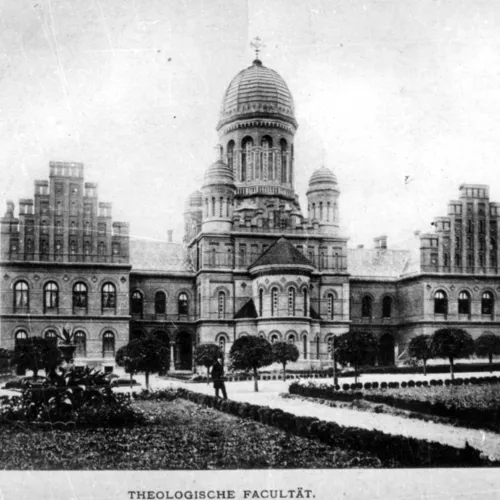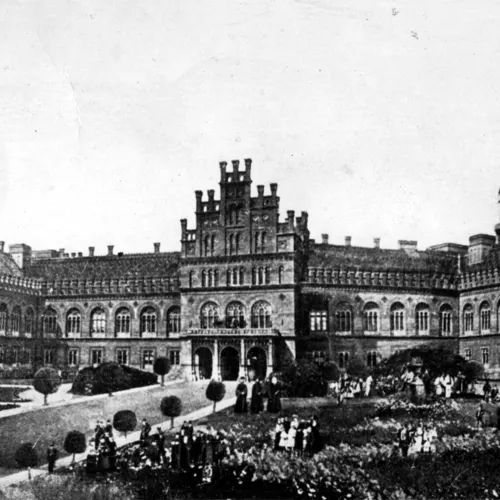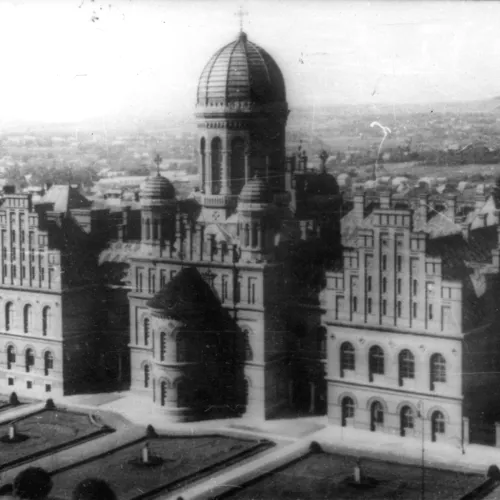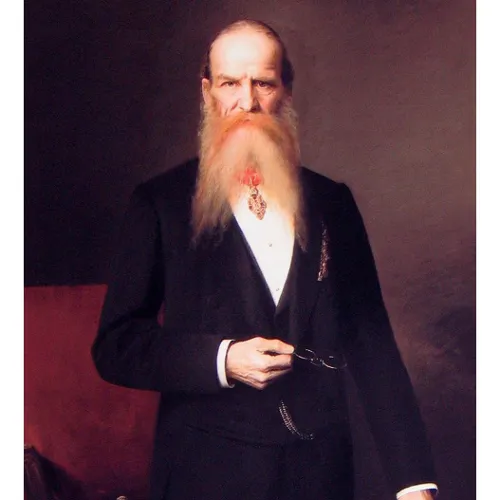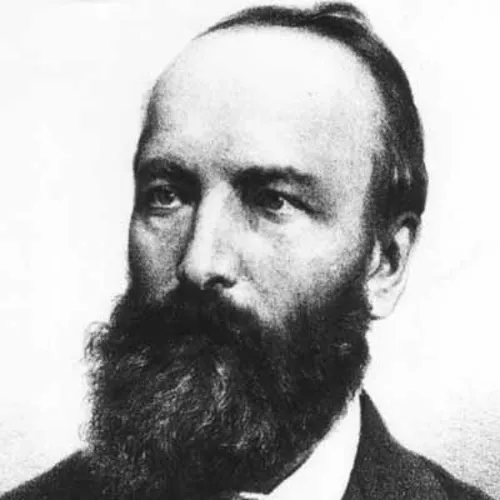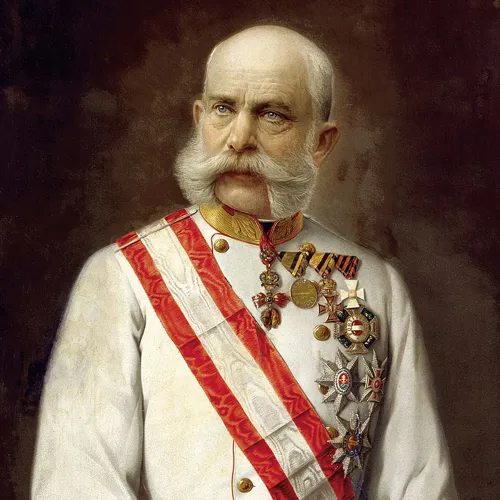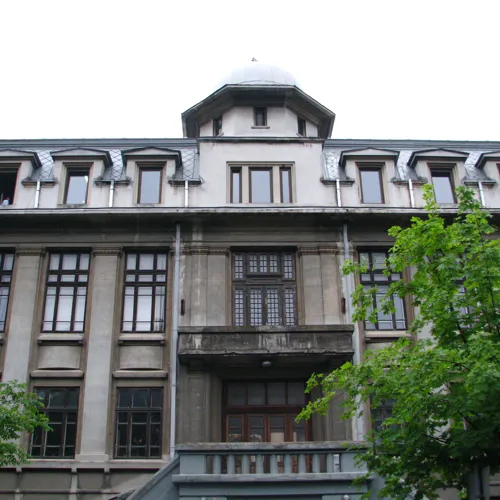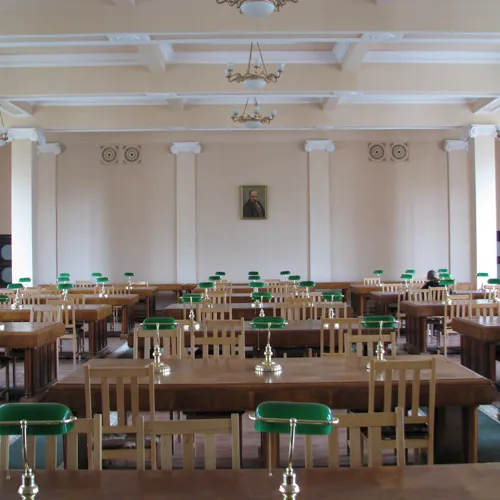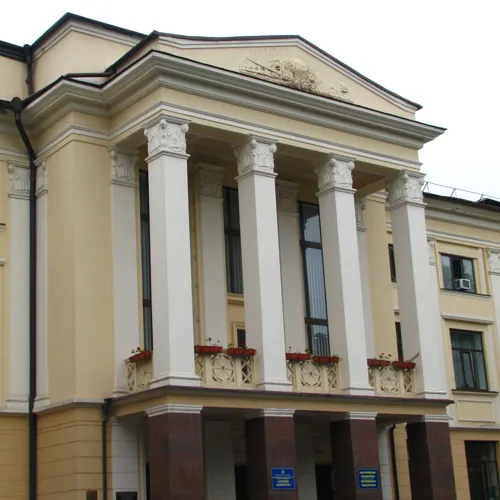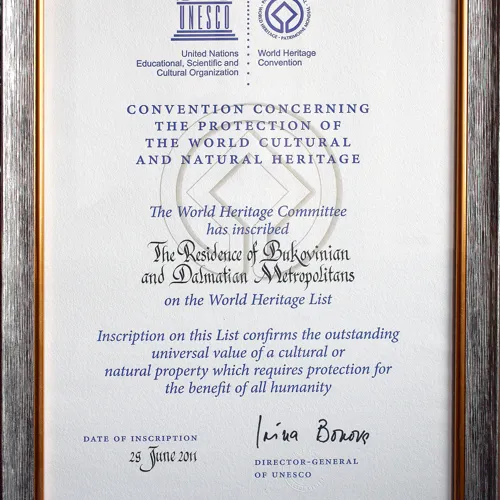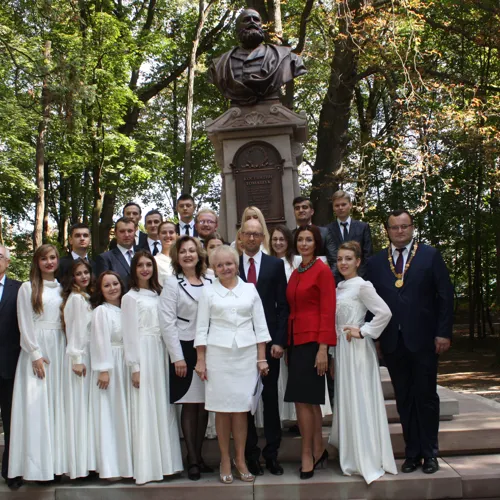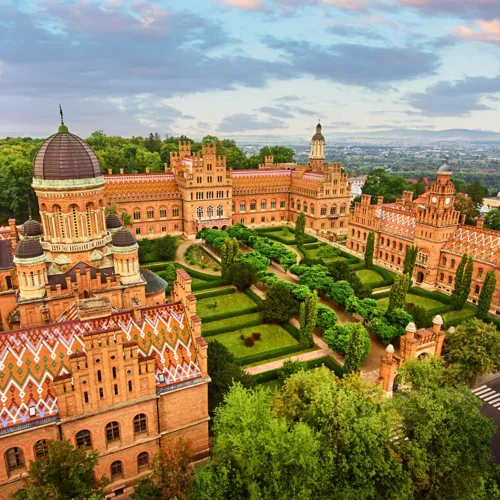Yuriy Fedkovych Chernivtsi National University is one of the oldest classical universities in Ukraine, which is located in Chernivtsi, and constitutes a complex built in 1864-1882 as the Residence of Bukovinian and Dalmatian Metropolitans according to the project of the famous Austrian architect of Czech origin, Josef Hlavka. Interior works were made by Viennese artists K. Iobst, I. Klein, Czech K. Svoboda, and Bukovyna artists E. Buchevsky and E. Maksymovych. The building combines the eclectic style with the dominant motives of Byzantine and Romanesque architecture.
In 1868 in the Bukovynian Sejm (parliament), a question about the establishment of a law academy in Chernivtsi was raised. At the meeting of November 28, 1872, the deputy of the region Dr. Kostiantyn Tomaschuk put forward and substantiated the proposal of establishment a university in Chernivtsi.
By decree of the Austrian Emperor Franz Joseph, dated March 31, 1875, the University of Chernivtsi was founded, including the Greek-Orthodox theological faculty – the only Orthodox faculty in the Austrian Empire.
On October 4, 1875, the official ceremony on the occasion of the opening of the university, which was given the name Franz Joseph University of Chernivtsi, took place.
During the 20th century, it changed its name several times: Franz Joseph University (German: Franz Josephs) (1875–1918), King Ferdinand I University (1920); Universitatea Regele Carol I din Cernăuţi (1933), Chernivtsi State University (1940). Since 1989, the University of Chernivtsi has been named after Yuriy Fedkovych. In 2000, after granting the institution national status, it received its modern name – Yuriy Fedkovych Chernivtsi National University (CHNU).
The first rector is the famous scientist and public figure Kostiantyn Tomaschuk.
European and world-class scientists taught and conducted research here: economist Joseph Schumpeter, lawyers Yevhen Ehrlich and Hans Gross, historian Raimund Friedrich Kaindl, mathematicians Leopold Hegenbauer and Hans Hahn, chemist Richard Psybram, philologists Stepan Smal-Stotsky, Omelyan Kaluzhnyatsky, Ion Sbiera etc.
Today, the University has 2 educational and scientific institutes:
- Institute of Biology, Chemistry and Bioresources, and
- Institute of Physical, Technical and Computer Sciences
and 10 faculties:
- Faculty of Geography;
- Faculty of Economics;
- Faculty of Foreign Languages;
- Faculty of History, Political Science and International Relations;
- Faculty of Architecture, Construction, Decorative and Applied Arts;
- Faculty of Pedagogy, Psychology and Social Work;
- Faculty of Mathematics and Computer Science;
- Faculty of Philology;
- Faculty of Physical Culture and Human Health;
- Faculty of Law;
- College.
In total, the institution has 73 departments, 55 of which are headed by Doctors of Science (75%).
The fundamental basis of the university's activity has always been and remains the academic staff, its scientific and pedagogical potential, capable of the high mission of training highly qualified specialists and citizens of Ukraine. Training of more than 14,000 students of higher education is carried out at 85 departments in specialties: I (bachelor's level) – 81; II (master's level) – 73; III (educational and scientific level) – 25, and scientific level – 11.
The educational process and scientific work is provided by 1,100 academics, including 160 professors, Doctors of Science, 15 academicians of the National Academy of Sciences of Ukraine, the National Academy of Pedagogical Sciences of Ukraine and the Academy of Sciences of the Higher School of Ukraine; 5 laureates of State Prizes of Ukraine; 39 – awarded with state awards; almost 750 associate professors, candidates of sciences.
The University has postgraduate and doctoral programmes, 9 specialized Academic Councils (5 of which are doctoral). In 2020, 3 one-time specialized councils were opened for the dissertation defence by decree of the Ministry of Education and Science of Ukraine. In 2020, 16 dissertations, including 11 candidate and 5 doctoral theses, were defended by all Specialized Academic Councils.
By the end of 2020, the training of higher education applicants for the degree of Doctor of Philosophy was carried out in 19 licensed specialties; Doctor of Science – in 12 specialties.
Dissertations were defended by postgraduate students, doctoral candidates, applicants, university employees: in 2017 – 12 doctoral and 42 candidate theses, in 2018 – 9 doctoral and 40 candidate theses, in 2019 – 20 doctorate and 46 candidate theses. 2020 – 16 doctoral and 22 candidate theses.
The University operates: the Ramon Hnatyshyn Canadian Studies Centre, the Centre for American Studies, the Centre for Romanian Studies, the Centre for German Language Studies “Gedankendah”, the Centre for Euro-Atlantic Integration and Security, the Centre for Bohemian Studies, the Centre for Comparative Romanian Philology named after H. Bostan, the Centre for Slavic Studies, the Centre for Judaica, Historical and Cultural Centre, etc.
The university has 18 buildings, 12 of which are educational ones. Among them, the architectural ensemble of the former Residence of Bukovinian and Dalmatian Metropolitans, which was transferred to the Chernivtsi State University in 1955 by the resolution of the Council of Ministers of the Ukrainian SSR. This was no accident, as theology students traditionally studied within its walls.
For the needs of students, there are 7 dormitories that comprise more than 3,000 places.
The university possesses one of the richest book collections – a Scientific Library with a fund of almost 2.8 million copies, a publishing house of CHNU “Ruta”, a sports complex, a research farm, a botanical garden, a geophysical observatory, natural, geological and ethnographic museums, a historical and architectural museum complex, information and telecommunication centre, UNESCO Site Management Centre, etc.
Next to the university there is an adjacent magnificent dendrological park with rare plant species.
There is an extensive functioning system of student self-government bodies that take an active part in the educational process, scientific and public life of the city and region. The student newspaper “Newformaty” is being published.
An important component of the functioning of a modern university is the international activity, within the framework of which the university has concluded 225 agreements with educational, scientific and cultural institutions with almost 30 foreign countries (agreements with Russian and Belarusian educational institutions were terminated unilaterally).
An integral component of international cooperation is the implementation of double degree programmes. Agreements on 16 joint EPP (Educational and Professional Programme) and ESP (Educational and Scientific Programme) with 9 institutions of higher education from 5 countries (China, Poland, Lithuania, Romania, Slovakia) have been concluded.
Professors and students participate in joint scientific programmes, which are carried out in accordance with agreements on creative cooperation with leading educational institutions and scientific institutions of the USA, Canada, Austria, Germany, Poland, Bulgaria, England, Macedonia, Romania, the Czech Republic, China, Israel and others countries. The international authority of the higher education institution is evidenced by such facts as the recognition of two professors as “Person of the Year” by the International Biographical Centre situated in Cambridge, the awarding of the title of “Honorary Doctor” to scientists from the universities of Saskatchewan (Canada), Suceava (Romania), and Beltsk (Moldova), and the awarding of grants to 14 professors, postgraduate students and university students, the Galileo Galilei Prize to Prof. O. Anhelskyi.
In October 1999, Chernivtsi University was admitted to the ranks of honorary members of the International Association of Universities “PhiBetaDelta” (USA). Since 2000, Chernivtsi University has been a member of the Danube Rectors' Conference.
In January 2009, the university became a member of the European Association of Universities, joined the Agreement on partnership in the creation of the Electronic Library of Ukraine (ELibUkr). Another defining moment is the positive decision to join Yuriy Fedkovych Chernivtsi National University to the Great Charter of Universities (MagnaChartaUniversitatum).
On June 28, 2011, on the day of the 15th anniversary of the Constitution of Ukraine, at the 35th session of the UNESCO World Heritage Committee the decision to include the Architectural Ensemble of the Residence of Bukovinian and Dalmatian Metropolitans (now the Central Building of the University) in the list of UNESCO World Heritage Sites was taken. Residence of Bukovinian and Dalmatian Metropolitans is the third Ukrainian object included in the UNESCO World Heritage List.
Currently, Yuriy Fedkovych Chernivtsi National University (the only one in Ukraine) performs a dual function: on the one hand, the centre of education, science and cultural heritage of the Bukovyna region, and on the other – a UNESCO World Heritage Site.
On October 4, 2015, on the day of commemoration of the 140th anniversary of the founding of the Chernivtsi University, the opening of the restored monument to the first rector of the University, a member of the Austrian Parliament and the Regional Diet, Honorary Citizen of Chernivtsi Kostiantyn Tomaschuk, took place. The monument was restored in the Central Park of Culture and Recreation named after Taras Shevchenko (in the former Chernivtsi City Park) at the place of its original installation in 1897.
The university has gone through a difficult path of existence and development, becoming a significant centre of education, science, and culture of the Bukovyna region and the entire western part of Ukraine.
